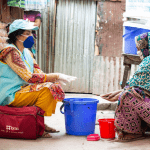Three Ways Technological Disruption is Fighting Inequality in Asia – And One Challenge it Hasn’t Yet Overcome
Asia has undergone unparalleled economic growth in the last 30 years. This massive wave of development, however, has put a strain on the region’s natural resources and presented long-term risks to its sustainability. And perhaps more importantly, this growth has been unequal in its reach and impact.
This inequality is experienced most strongly by those at the base of the pyramid (BoP) – people earning less than US $6-8 a day – and especially women and children. As a result of their existing vulnerabilities, these sectors of society have been disproportionately exposed to the negative consequences of rapid developmental shifts, and they continue to live in economic systems that are largely informal, with few securities.
Should economic development continue on this path, Asian countries can expect to face not only widespread food insecurity and pollution, but also higher levels of poverty – and in the worst-case scenarios, civil and international unrest. Fortunately, solutions exist. For instance, social investment in technology can empower the BoP by expanding financial inclusion, access to healthcare and gender equity, as seen in the following examples.
Technology as a vehicle for financial inclusion
By harnessing innovation and inclusivity, fintech contributes to financial inclusion by providing a mechanism through which mainstream and traditional lenders are able to extend their reach to traditionally unbanked groups. The Chinese market has taken the lead on using fintech to this end. Ant Financial, a fintech platform owned by Alipay, has been able to improve financial access to both businesses and individuals by employing an innovative and catchy “310” marketing message: “3 minutes to apply for credit, 1 second to approve, and 0 people involved in the decision.” Through the use of proprietary AI and risk-management technologies, this model has been able to maintain a non-performing loan ratio for business loans of around 1%. Over five years, this platform has disbursed over $100 billion in loans to 4 million micro and small businesses, and enabled 160 million rural residents to pay for products, buy insurance and access loans. Ant Financial is an engaging, easy-to-access and easy-to-comprehend model that has been able to traverse social, geographical and infrastructural barriers to benefit a large user base. It illustrates how this sort of fintech platform can enable the growth of markets, increase access to capital to help businesses scale, and empower underserved communities in a dynamic and ever-evolving manner.
Technology as a boon for health care
Healthcare is another area where resources are limited and patient demands are growing. Khushi Baby is a social enterprise based in India that uses near field communication (NFC) technology and mobile software to improve service delivery in maternal and child healthcare. NFC technology is leveraged in the form of a pendant that is worn around a patient’s neck, containing a decentralised digital copy of the mother or child’s health records, and allowing for the easy transmission of this data to health workers. The pendant is also connected to a phone app, which promotes patient engagement in self-care by triggering regular reminders for check-ups and medication. This has the effect of giving patients some degree of control over their own health, and ensuring that life-saving follow-up care is delivered in a timely and patient-specific fashion, whatever the circumstances.
Technology as a democratising force
Technology is also a means by which people at the BoP are able to access opportunities that might otherwise be beyond their social status and reach. With growing mobile phone penetration and declining internet data rates, women – who have typically been confined to the domestic or informal spheres – are able to access new opportunities.
One example of this is M-Pesa, the well-known Kenyan mobile money service, which is estimated to have lifted 185,000 women out of irregular farming jobs to secure positions in administrative or sales roles in formalised businesses over roughly 10 years. With access to 110,000 agents (in a country with only 2700 automatic teller machines), women now have direct access to remittances. This has paved the way for them to exercise greater agency in allocating their resources and time towards skills training, and enabled them to break into professional networks. With newfound asset ownership and financial independence, Kenyan women have experienced a steady upsurge in social mobility since mobile money was introduced to the country in 2007.
The Limits of Technology in Changing Power Structures
However, not everyone across Asia’s diverse countries has been able to benefit from improved access to technology in this way. In fact, the reverse has been true in Bangladesh. As a result of men having predominant access to technologies like mobile phones (along with greater decision-making power within families), Bangladeshi women – who were already at the margins of society – have found themselves further alienated, both financially and socially.
In a country where there is often only one phone per household in rural areas, which is often held by the male head of the household, women remain excluded from financial flows despite the exponential growth of male engagement in fintech. Additionally, with lower literacy levels than men, and the fact that Bangla is not an operating language on mobile platforms, women’s persistent exclusion from fintech presents complex, ongoing challenges. This goes to show that while technology has democratising power, it can also have the effect of reinforcing existing power dynamics. The impacts of technology’s growth are often based on who has access to what type of technology – which in turn is defined by existing power structures.
The need for a dynamic social ecosystem
Despite its vulnerabilities, the BoP presents a value-creating, resilient, creative and ideal sector of society for innovative tech partnerships – but it requires more strategic investments to transform this potential into reality. In both developing technology-focused solutions and directing capital to support them, it is important to pay attention to social dynamics, so as to ensure relevance for all potential beneficiaries and not worsen existing inequalities.
As the ubiquity of technology in development expands, stakeholders must take active steps to ensure that users feel both protected and empowered. This calls for a vibrant and dynamic ecosystem that includes the participation of policy-makers, investors, social enterprises and other intermediaries – such as investor networks – to exchange and challenge existing views and develop innovative solutions that build on mutual values and strengths. It is through such an ecosystem that mass inclusion can be ensured while working towards development goals.
This is where the power of impact networks like AVPN comes into play, bringing people together to do what one individual or organization can’t achieve alone, driving campaigns to transform the status quo, and bridging divides to ignite better solutions. Find out how you can leverage the power of this network as a funder and capacity builder or a social enterprise.
Sangeetha Watson is a Senior Associate with the Knowledge Centre at AVPN.
Photo provided by author.
- Categories
- Social Enterprise, Technology



